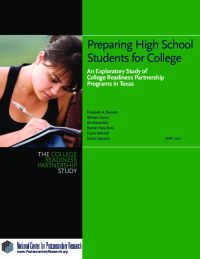Preparing High School Students for College
An Exploratory Study of College Readiness Partnership Programs in Texas
About 40 percent of traditional college students take at least one remedial course to prepare for college-level coursework. According to scholars and policymakers, one cause of this problem is the misalignment of high school graduation standards and college academic expectations. College readiness partnership programs attempt to address this problem by facilitating students’ transition to college. These programs, co-sponsored by a college and K-12 organization (usually a high school), are explicitly designed to prepare high school students to enter college ready to undertake college-level work.
The current study, published by the National Center for Postsecondary Research (of which MDRC is a partner), examines a number of college readiness partnership programs operating in Texas and identifies their features, targeted students, and intended outcomes. It also examines the partnerships that created these programs. The findings presented here are based on a search and analysis of the relevant research and Texas policy literature, an online scan of college readiness partnership programs in Texas with a web presence, and site visits to high schools, colleges, and community-based organizations in the Houston and Dallas — Fort Worth areas. The authors observed that most college readiness partnership programs could be classified into two types: those that focused on academic subjects and those that focused on college knowledge. The former tended to be intensive, short-term programs that targeted a small group of students and provided a direct experience of college; the latter tended to be light-touch, long-term programs that were open to all students and provided little direct experience of college.
Although few rigorous evaluations of these programs have been conducted, their potential to improve college readiness for students in the "academic middle" is generally supported by the literature and the research presented here. The authors identify a number of implications for college readiness partnership programs and the partnerships themselves. It is clear that college readiness partnerships create opportunities for secondary and postsecondary institutions to leverage each other’s services, eliminating redundant services and aligning programming to maximize gains for students. In some cases, college readiness partnership programs also lead to long-lasting relationships between institutions and continued collaboration. College readiness partnership programs may have the best chance of improving outcomes if commonly encountered challenges — such as issues related to student recruitment and program sustainability — are considered early in the planning stages. The authors emphasize the value of choosing interventions that show the greatest promise in a given context and matching students to the interventions that best meet their needs; they also note that building a stronger evidence base would enhance high schools’ and colleges’ ability to make sound decisions about which potential program models to implement.






